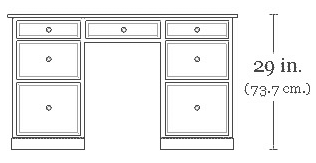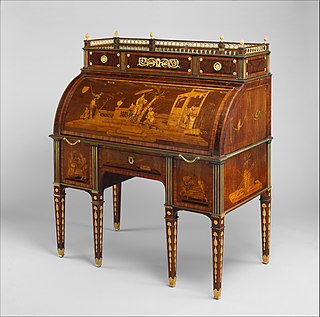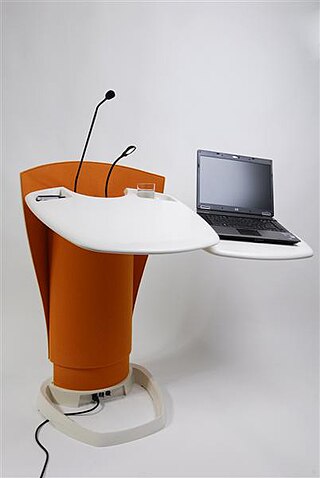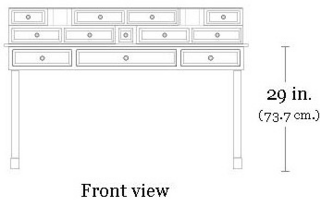This article includes a list of references, related reading, or external links, but its sources remain unclear because it lacks inline citations .(January 2024) |
This is a list of different types and forms of desks.
This article includes a list of references, related reading, or external links, but its sources remain unclear because it lacks inline citations .(January 2024) |
This is a list of different types and forms of desks.

An armoire desk is a writing-table built within a large cabinet, usually 1.5–2.0 metres high. The cabinet is closed by two to four full-height doors, to keep out dust or to give a tidy appearance to a room by hiding the cluttered working surface of the desk. This form of desk is usually placed against a wall, like its antique uncle, the secretary desk.

A desk or bureau is a piece of furniture with a flat table-style work surface used in a school, office, home or the like for academic, professional or domestic activities such as reading, writing, or using equipment such as a computer. Desks often have one or more drawers, compartments, or pigeonholes to store items such as office supplies and papers. Desks are usually made of wood or metal, although materials such as glass are sometimes seen.

A pedestal desk or a tanker desk is usually a large, flat, free-standing desk made of a simple rectangular working surface resting on two pedestals or small cabinets of stacked drawers of one or two sizes, with plinths around the bases. Often, there is also a central large drawer above the legs and knees of the user. Sometimes, especially in the 19th century and modern examples, a "modesty panel" is placed in front, between the pedestals, to hide the legs and knees of the user from anyone else sitting or standing in front. This variation is sometimes called a "panel desk". The smaller and older pedestal desks with such a panel are sometimes called kneehole desks, they were intended for small spaces like boudoirs and were usually placed against a wall. The kneehole desks are also known as bureau tables.

The cylinder desk is a desk that resembles a Bureau Mazarin or a writing table equipped with small stacked shelves in front of the user's main work surface, and a revolving cylinder part that comes down to hide and lock up the working papers when the desk is not in use.

A writing table has a series of drawers directly under the surface of the table, to contain writing implements, so that it may serve as a desk. Antique versions have the usual divisions for the inkwell, the blotter and the sand or powder tray in one of the drawers, and a surface covered with leather or some other material less hostile to the quill or the fountain pen than simple hard wood.
The fall-front desk is a desk with a main working surface that folds up to cover small shelves or drawers stacked in front of the user. As with its cousin the secretary desk, all working papers, documents and other items have to be stored before the desk is closed.

The slant-top desk, also called secretary desk, or more properly, a bureau, is a piece of writing furniture with a lid that closes at an angle and opens up as a writing surface. It can be considered related, in form, to the desk on a frame, which was a form of portable desk in earlier eras.

There are two kinds of trestle desk: as with trestle tables, some have trestles joined by one or more stretchers, and some have free-standing trestles. They can be dismantled, with the desk top removed from the trestles, for storage or transport.

The lectern desk exists in two distinct forms, antique and modern.

A bureau à gradin is an antique desk form resembling a writing table with, in addition, one or several tiers of small drawers and pigeonholes built on part of the desktop surface. Usually the drawers and pigeonholes directly face the user, but they can also surround three sides of the desk, as is the case for the Carlton house desk form. A small, portable version is a bonheur du jour.

The bureau Mazarin is a 17th-century desk form named more or less in memory of Cardinal Mazarin, who was the Chief minister of France from 1642 to 1661. It is the earliest predecessor of the pedestal desk and differs from it by having only two tiers of drawers or three tiers of rather small drawers under the desktop surface, followed by eight legs supporting the whole. Also, the bureau Mazarin has cross braces between the legs, forming two Xs or two Hs on each side.
The fire screen desk is a very small antique desk form meant to be placed in front of a fireplace to keep a user's feet warm while he or she is stationary while writing. This kind of desk was very popular in prosperous homes in Europe during the 18th century and slowly disappeared during the 19th, with the gradual introduction of stoves and central heating.

Jean-Henri Riesener was a famous German ébéniste (cabinetmaker), working in Paris, whose work exemplified the early neoclassical "Louis XVI style".

A Carlton House desk is a specific antique desk form within the more general bureau à gradin form. This form of desk is supposed to have been designed in the 18th century for the Prince of Wales by George Hepplewhite. It is named after Carlton House, which was at the time the London residence of the Prince, and sometimes is also known as a Carlton House writing table.
The secretaire en portefeuille is an antique desk form which is usually mounted on rollers at the end of four jutting legs. The legs in turn support what looks like an oversize vertically mounted wooden pizza box. This is a cabinet a few inches thick, with barely enough space in it for the raised desktop surface and a few pens and sheets of paper disposed vertically. It is also called a "Billet doux".

Martin Carlin was a Parisian ébéniste (cabinet-maker), born at Freiburg, who was received as Master Ébéniste at Paris on 30 July 1766. Renowned for his "graceful furniture mounted with Sèvres porcelain", Carlin fed into the luxury market of eighteenth-century decorative arts, where porcelain-fitted furniture was considered among "the most exquisite furnishings" within the transitional and neoclassical styles. Carlin's furniture was popular amongst the main great dealers, including Poirier, Daguerre, and Darnault, who sold his furniture to Marie Antoinette and many amongst the social elite class. He died on 6 March 1785.
Gilles Joubert (1689–1775) was a Parisian ébéniste who worked for the Garde-Meuble of Louis XV for two and a half decades, beginning in 1748, earning the title ébéniste ordinaire du Garde-Meuble in 1758, and finally that of ébéniste du roi on the death of Jean-François Oeben in 1763. He produced case furniture in a robust Rococo style, ranging from simple veneered bidets to grand commodes that integrated gilt-bronze mounts into the forms of furniture with subtle three-dimensional curves (bombé). From the later 1760s his furniture increasingly shows a conservative compromise with the nascent neoclassical style.
Néotù was a contemporary furniture gallery founded in 1984 in Paris.

The furniture of the Louis XV period (1715–1774) is characterized by curved forms, lightness, comfort and asymmetry; it replaced the more formal, boxlike and massive furniture of the Louis XIV style. It employed marquetry, using inlays of exotic woods of different colors, as well as ivory and mother of pearl.

Louis XVI furniture is characterized by elegance and neoclassicism, a return to ancient Greek and Roman models. Much of it was designed and made for Queen Marie Antoinette for the new apartments she created in the Palace of Versailles, Palace of Fontainebleau, the Tuileries Palace, and other royal residences. The finest craftsmen of the time, including Jean-Henri Riesener, Georges Jacob, Martin Carlin, and Jean-François Leleu, were engaged to design and make her furniture.